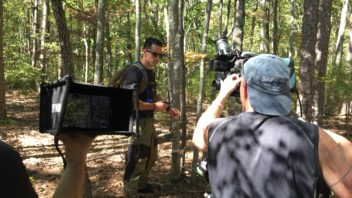So, how tough could it be with today’s technological advances to successfully film and edit a complete video project? Most people would probably say, “Not too hard!” or “We got this! It’s not even a thing to worry about!”
We are able to purchase flip cameras for $100 and when it comes to editing, laptops are sold pre-installed with basic programs. As a newbie to the business, I’ve learned that it’s vital to keep an open mind and consider more than price when it comes to creating your own videos versus paying a professional.
If you are going to do it yourself, make sure you have the right equipment. One thing many people don’t consider is the audio. While you can get a camera that shoots in high definition, it may be hard to find a good microphone that goes with it. Consider looking on EBay for an older professional camera that has audio inputs. The consumer cameras simply don’t have an input for getting good audio.
This is a lesson I learned the hard way. When doing a video for a class, I used a regular home video camera, a digital camera that takes both stills and video. I used a pre-installed editing software program. The assignment: a two to three minute video of a Spanish soap opera. There were three of us, and we did everything. We were the shooters, editors, producers, and actors. While we were relatively pleased with our cheesy little soap opera video and could live with the bad acting, we were disappointed in both the lighting and the audio. Our on-camera mic was horrible outside with the wind noise, and the lighting inside left a lot to be desired.
With this experience, I have just a few thoughts in doing it yourself versus hiring a pro. Consider time, cost, and quality.
If you do it yourself, you will spend a lot of time. Give yourself time and practice using your equipment before even considering trying to shoot a video for your business. Trust me. There is a learning curve to all this great stuff on the market. Be sure to plan your video. Consider who will speak, if you will need actors, what your locations will be, what your shots will look like and what you want your audience to feel or do when viewing your video. Will you have a call to action at the end?
There are some definite pros to doing it yourself: If you really love video, then you could have a lot of fun with it. You will definitely save money.
The cons to consider are your time and the quality of the video. What took my group four days to do, MVP can do in a few hours. While doing it yourself can certainly save you money, be sure to consider the cost-effectiveness of your savings. Is working an extra 20 to 40 hours worth saving what a professional company may be able to do in 4 to 5 hours? Think of it this way: if you typically work for $100 an hour and you lose out on 20 to 40 hours of profit, you would be missing out on $2000 to $4000.
Additionally, try to avoid doing what I did. Expect a learning curve, not just in learning to operate the camera and editing equipment, but also learn a little about lighting and angles beforehand. It will also take a while to develop an efficient process for video production. Another factor to consider is quality. Competing with other professional videos on the market will be challenging. Professional companies simply have better equipment and the experience that goes with creating videos everyday.
So take it from a newbie’s perspective, video filming and editing is no easy task when you loop quality and efficiency into the creative process because it takes more than a camera and some editing software to produce a worthwhile product. I’ve seen projects at MVP that have been revamped and tweaked so many times in countless ways to achieve the ultimate final product under particular time constraints.


